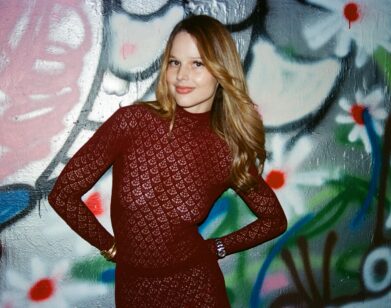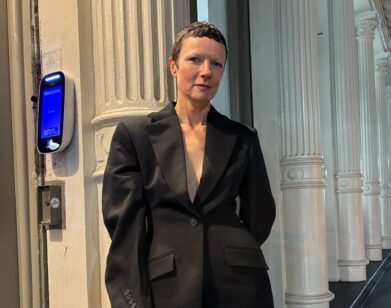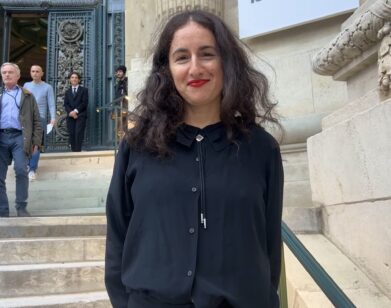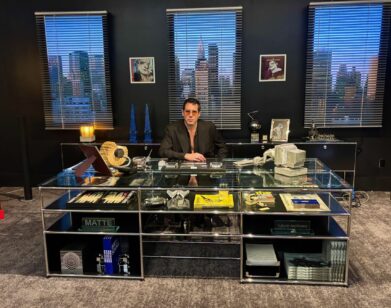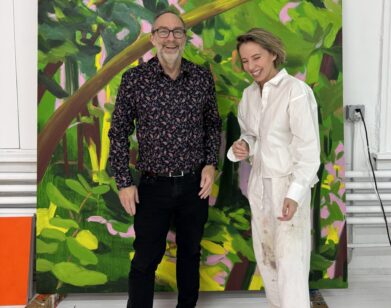Pipilotti Rist: Rooms With Many Views
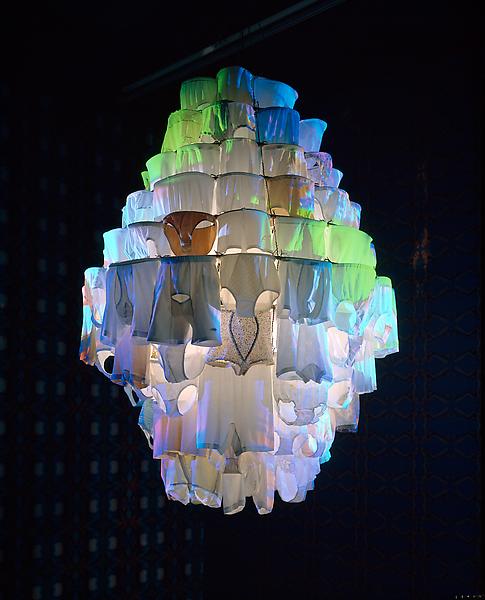
LAYERS MAMA LAYERS, COURTESY THE ARTIST AND LUHRING AUGUSTINE
“Heroes of Birth,” by Pipilotti Rist opened on September 11, 2010, at Luhring Augustine. The show marked a subtle shift from her last exhibition with the gallery six years ago. Disposing of visual props, the main room of the show features Layers Mama Layers (2010), several dissections of scrim suspended from the ceiling that submerge the viewer in pastoral projections. The work creates different effects depending on where you stand in the room. We spoke to her about heroism, video art, cinema, and the white cube.
JILL CONNER: Your show opened on the ninth anniversary of the World Trade Center attack. Was the date meant to correlate with the title, “Heroes of Birth?”
PIPILOTTI RIST: I titled my show “Heroes of Birth,” which sounds quite similar but is completely different. What you are referring to is more like “Birth of the hero.” The title was a complete coincidence although I am also interested in what we look to as role models. I was reading an essay by a philosopher last week who said, “Normally we are not afraid or concerned about the time before we have been.” Maybe we should take this as a comfort.
CONNER: Are you interested in any philosopher in particular?
RIST: Nassim Nicholas Taleb wrote, The Black Swan: The Impact of the Highly Improbable (2007), and said that so many things happen throughout the course of time, but when we look back we tend to organize the information so that it makes sense to us individually. We want to have a logic or a fate.
CONNER: And it’s usually subjective since the flaw of an individual memory is to organize events differently from that of another, creating a different linear representation.
RIST: Whenever we remember a series of events, we remember them different. We are constantly changing. It’s a flaw, but on the other hand, when we say a word, the meaning is not what you put into it. Rather, the meaning of the word is all of the past usages of that word. Like this cloud that makes up the meaning of the word. It’s your subject if you write. For instance what you put in that word and what you assume it means, even its flaw. It has a general agreement.
MASSACHUSETTS CALENDAR, 2010
CONNER: I have always been swept up by your work. But there are space limitations in a gallery. How does that affect the impact of your work?
RIST: If the room is given, I make and adapt. For MoMA, it took me five years to develop the project, because the first proposition I made was not feasible. The gallery here has two additional rooms, but it’s true this is quite a small show, with only three works.
CONNER: Layers Mama Layers gains its depth based upon where one stands in the work. It gets brighter if you’re closer to the projector and fainter when you stand further away.
RIST: It’s quite a geometrically structured work and not focused only on the emotional since it also lets one think about the layers. You can see through the dark colors and the bright. You can also think about perspective when you want.
CONNER: My naïve assumption about video art is that it will appear as a square, film projection upon a wall.
RIST: But that’s the big difference between video and cinema. In video you don’t have to look at everything from one direction. My work is less authoritarian than that. In this piece, you can decide yourself how you want to walk.
CONNER: I like how you break up the space, the image, the experience and the view.
RIST: I’ve always thought that if video art could have been part of cinema, history would have been different, since in every cinema you go to there is a room in the entrance where you have 20 minutes before you go to the film. In video, you have this free walk-in before the art beckons the viewer to come into its protected space—like a science experiment of its own kind. Movie theaters are closing and just yesterday I talked with a guy from cinema who asked me if I could bring my work over.
CONNER: You would have to rip out the seats.
RIST: Yes, and we would have a lot of spaces. You could use the old technique and the recycling of their resources.
CONNER: The space should be opened up into a more interactive environment.
RIST: It’s a hard time now for cinema since the size of the flat screen keeps growing bigger. There’s no reason for anyone to go to the movie theater anymore. I would like it if people in the living room used their time more freely, and I hope that video art can them think of ways to use their machines more creatively. TV is nothing other than light with meaning, so if you just put the monitor up above, more things can happen again. Maybe you sometimes don’t want to interact and would prefer to just sit there, calm, to use some other parts of the brain, because even the biggest part of our head is for language.
One thing I don’t understand is why people do not choose to put their LCD monitors more upwards on the wall, toward the ceiling, because then they would have more space in the living room, and they could lie down to watch TV. It makes no sense that you have to look directly at it while sitting up. Maybe they are too afraid that they will go to sleep.
CONNER: Creativity and mathematics are supposed to operate on different sides.
RIST: Actually they don’t know completely, but what they do know is that when we have a problem, we are parallel processing. That’s why we have difficulties with getting computers to match our brain. The knowledge or processing goes through one tunnel, like the neck of the computer.
CONNER: What do you find alluring about the white cube and its empty spaces?
RIST: The white cube for me is interesting because there are no windows and I’m bringing in my own light. But actually the white cube, as such, is a difficult thing due to the presence of the white. Only a hundred years ago, or a bit more, the public galleries covered their walls with ornate wallpaper and the hanging was salon style. But also, the domestic living room looked the same as well. However now, the living room looks like the white cube! It’s mostly the parallel hanging and it’s white. This development came in the 1920s and is actually hard to pinpoint in history, when the living space moved from color to white. And of course the reason is that you want concentration with nothing around. For the living it’s hygienic, it’s clean—Le Corbusier introduced that notion.
CONNER: I was just thinking of Le Corbusier, in fact, since he was into sanitizing the history out of the built structure, correcting the idea of traditional space by sanitizing the overbearing weight of tradition.
RIST: Exactly! And make it clean, healthy, meditative, and open. White means a lot of possibilities for what can happen. But what I never understand is why are galleries like living rooms and living rooms like galleries?
CONNER: And yet your work deconstructs the white cube into an ethereal, transcendental space that doesn’t always happen in the white cube.
RIST: Of course it’s easier for a video artist, because when you make a whole wall, you also blow it away. It’s like you open up the architecture and you dissolve the wall. White is too much reflection for me. You said sanitary but then of course there’s the light. People want to reflect as much light in their living rooms as possible. That’s one other reason. In the evening, the lights go down, and when they make punctual light of course the white becomes gray and loses color.
HEROES OF BIRTH IS ON VIEW THROUGH OCTOBER 23. LUHRING AUGUSTINE IS LOCATED AT 531 WEST 24 STREET, NEW YORK.

